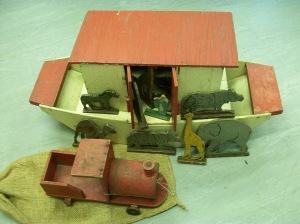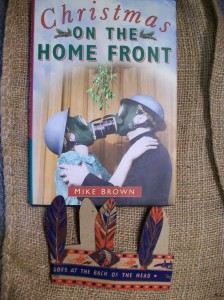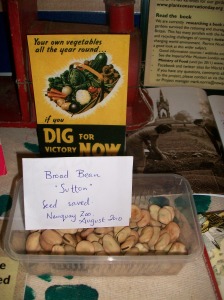Bumper August holiday edition of the blog: The World War Zoo garden at Newquay Zoo celebrates its second anniversary on August 31st 2011. Packed with extra reading and some fun things to do!
- Wartime holiday reading – the dramatic front cover (The Altmark story) of Boy’s Own Paper August 1940 Price 6d (Image from the World War Zoo collection, Newquay Zoo)
I’ve been reading again for the first time since childhood Robert Westall’s The Machine Gunners, set in the same area where he grew up. This has been really useful background for help in editing a 1941 diary of a teenage girl from Tynemouth which I’m working on in evenings at the moment (deciphering the spidery handwriting etc.) and typing this up for schools publications / general readership. There is more on the Tyneside area at war in www.ne-diary.bpears.org.uk set up by Brian Peers and Roy Ripley and more on Robert Westall at www.robertwestall.com Robert Westall’s work is featured in the excellent new exhibition on wartime children’s stories at Imperial War Museum London http://wartime.iwm.org.uk/ with lots of events in the August holidays. Once Upon A Wartime: Classic War Stories for Children runs from 11 February to 30 October 2011 at Imperial War Museum London.
We’ve updated last August’s bumper post as we’ve had lots of comments and contacts about it. So here goes …
August, our second garden anniversary amid school holidays with Newquay Zoo www.newquayzoo.org.uk and busy local Cornish beaches, full of children and their families enjoying sunshine, picnics, animal feeding talks and each other’s company (along with the odd temper tantrum and family row). Many stop to look at the fresh veg, flowers and busy bees of the World War Zoo garden, soon to be celebrating its second anniversary at the end of August 2011. Sadly the cares of the office and family back home are never far away, judged by awkward mobile phone conversations by fraught vistors back home to the office. Was life simpler and easier in the days before mobile phones?
Holidays in wartime were increasingly more of a ‘staycation’ variety, with ‘Is Your Journey Really Necessary?’ posters and petrol rationing, wired off and mined beaches with troops tensely awaiting invasion and Home Guards watching the shoreline from pillboxes, rather than today’s RNLI lifeguards.
Many of the older generation still loyally return to Cornwall where they were brought as children on family holidays or as evacuees. Newquay has recently seen another anniversary trip by staff and boys of Gresham’s School, 70 years on from the school, like Benenden Girls School, moving from the battlefields of the South Coast to Newquay and Cornwall. The holiday period of this time is vividly captured in the late Bettye Grey’s reprinted memoir of Newquay life, “Oh Get On!”
Already in early August there must be children moaning “I’m bored!” to parents. What would a wartime school child do in their extended holidays, either in their evacuation centres or increasingly at home returned from evacuation billets when not much was happening in the ‘Phoney war’ and often with no schools to go to?
In a battered and yellowing copy of the Boy’s Own Paper for August 1940 in the Newquay Zoo World War Zoo gardens wartime life archive can be found the following rousing instructions from the Editor for young men (and their sisters):
“Be British [quoted as the last words of Captain Smith of the Titanic] and summon up your nerve and heart and sinew to carry on with your job – your harvesting, your waste-paper-collecting, the repairing of the school air raid shelters, black out blinds, fire service, first aid.”
“Write home often, and tell those anxious people how jolly all right you are; and let your whole being throb with the almighty unconquerable challenge –“Let them come!” Brace your muscles every time you think of it, let it resound from your spade when you give an extra hefty jab into the earth of the school garden plot. Let your nostrils dilate, your eyes kindle with a fierce gleam as, with fists clenched, you surge out that mighty challenge between set teeth. Go to it, lads!” (Editorial, Boy’s Own Paper, August 1940)
Never has gardening been so breathlessly described in such “ripping” terms. Another article begins:
“All of you who have a garden have, I know, been digging for victory, and now your crops are up you can see what can be done by hard work, and penny packets of seed. Every potato, parsnip, carrot, beetroot, every row of peas or beans, every lettuce or tomato on your plot of ground is going to help us win through, and what is more, it is your very own contribution to victory. Having dug for victory, I am now going to talk t you about feeding for victory. I don’t mean by this that you should sit down and eat up all your crops. I mean feeding livestock.”
“Why not keep one or two rabbits, a few chickens or half a dozen bantams? … and some have a large enough garden, perhaps to keep a pig, or there may be adjacent to the garden a rough piece of meadow or waste land to poor to grow crops but where a goat could pick up a living and provide you with milk … How ripping, too, if there was also honey for tea from your own bees … doubly welcomed now we are rationed with sugar …” (“Feeding For Victory”, Boy’s Own Paper, August 1940).
Followed by W. E. Shewell-Cooper’s Garden and Allotment What You Can Do series, August’s article being ‘How To Get Good Garden Crops’:
“August is a harvesting month. It isn’t as big a harvesting month as September, of course, but there is lots of harvesting work to do. Take the French beans and runner beans, for instance …”
Not many years ago, there was a brief nostalgia flourish of the “Dangerous Book for Boys” genre and not-so-dangerous companion book for girls. Many journalists and childhood experts lamented the modern safety-obsessed, neglectful or over parenting of the ‘play safe, play at home, computer and text obsessed, short attention spanned, foul-mouthed, under-parented, disrespectful, drunk, promiscuous, overweight and more miserable generation’ of 21st century children and teenagers in Britain than anywhere else in the developed world. Many in Newquay have been fighting back recently against adverse publicity regarding this generation on holiday without parents for the first time.
My friend Sue Palmer, author of Toxic Childhood, Detoxing Childhood, and 21st Century Boys (all by Orion, see www.suepalmer.co.uk ) would no doubt approve of the vigorous and earnest pursuits suggested or sold to Boy’s Own Paper readers in the August 1940 edition. Recently in July 2011 Diarylea have published a report on rethinking childhood by Tim Gill http://rethinkingchildhood.com/2011/07/21/dairylea/
There are plenty of activity ideas “for the growing boy” in the Boy’s Own Paper August 1940 (B.O.P Motto: Quicquid Agunt pueri nostri farrago libelli, or “Whatever boys do makes up the mixture of our little book”) for boy craft of days gone by. Amongst the rousing tales of daring-do and technical articles on “Submarines: what they are like and how they are operated” (at a time of rationing and increased Merchant shipping loss to Nazi U-boats) are some fascinating adverts.
What boy could be bored, tempted by naval careers or radio officer training colleges (“A career of national importance in wartime with an assured future in peace-time”), Skywaymen of the BOP Flying League and their aircraft recognition card games, Cold Ovaltine “the best summer drink”, Brylcreem and discreet booklets on “Sex Problems … if you are puzzled about the secrets of birth” in “Knowledge for the Growing Boy” (6d, post free.)
What does the holiday weather matter as wartime boy when there is always the latest model anti-tank gun or make-it-yourself ship or plane models, photographic chemicals, stamp collecting advice care of Stanley Gibbons (in the centenary year of the Penny Black and Penny Post 6th May 1840), cricketing tips, pen pals seeking fellow “aviation enthusiast” or “cricket enthusiast”, explosive chemistry experiments, canoeing or cycling adventures (with blackout shielded headlamps, naturally). There were of course for some, visits to the local zoo, if it had reopened as a morale booster and a touch of normal pre-war life.
There was also the salvage of aluminium kitchen goods to collect and sort out, as part of COGS (Children on Government Salvage), during the July and August 1940 appeal by Lord Beaverbrook for saucepans for Spitfires! This campaign features comically in William at War, one of the Just William books reprinted in the 2009 “Still Naughty at Ninety” anniversary of Richmal Crompton’s boy wonder. Find more in the www.panmacmillan.com the A- Z author list.
Rainy summer’s day inside ? You could design or update a wartime poster for the New Home Front campaign www.newhomefront.orgclosing date September 2011 (see previous posts).

Spitfires, Stukas, George and the Dragon: Newquay War Weapons Week poster design from Carmen Blacker and Joan D Pring at Benenden Girls School, evacuated to Newquay in the 1940s. Copyright: World War Zoo project, Newquay Zoo
The life of a 1940s boy (or tomboy girl) seems exhausting and busy by modern standards! Amongst many memoirs and histories of wartime children, Mike Brown has written a fabulous short Shire Library Book on Wartime Childhood www.shirebooks.co.uk which illustrates the varied activities, challenges and opportunities of my parent’s childhood. Two of our handmade wartime toys – a Spitfire and a wooden sliding puzzle – from the Newquay Zoo wartime life collection can be found on the BBC www.bbc.co.uk/ahistoryoftheworld
If you want to recapture some of this indoor childhood activity, Airfix are very proudly advertising their kits again through http://www.airfix.com/ in the pages of BBC History Magazine http://www.bbchistorymagazine.com/ including an anniversary Battle of Britain range and RAF airfield (just like the one my granddad served on) with proceeds to veterans’ charities. The Airfix Club flies again for a whole new generation of paint-splattered boys and girls!
So “Go To IT!” down your local garden centre! Gardening was also part of this manly (boyish or tomboyish) existence, amongst the columns of nature notes such as “The Wonders of Crab Life” by H. Chapman Pincher BSc, (surely not the controversial Spycatcher writer of later years?) – and “Through the Hedge and over the Downs” by ‘Hedgerow’. We saw lots of native wildlife such as bees, birds and dragonflies flitting and buzzing around Trelawney Garden Centre and its lakes (with rumours of kingfishers) last August, amid many chats about our live insects, sloughed spider moults, wasp nest sections or dried specimens of Death’s Head Hawk moth. ‘Hedgerow’ notes topically for August 1940 “What to look out for this month: Hawk moth larvae; Privet Hawk on Privet: Eyed Hawk on willow, Lime Hawk on lime or elm, Elephant Hawk on Willow Herb. Dunlin or Ox birds by the seashore. Corn Buntings and yellowhammers by the Cornfields. Butcher Birds’ larders in the hedges. Teazles in Bloom. Wasps’ nests.” A refreshing sight for the sore limbs of many a Land Girl or Victory harvest schoolchild working in the August fields, but also sign of how Britain’s wildlife has changed in 70 years, If you haven’t signed it yet, sign up via www.signtheletter.org.uk to the RSPB’s Letter to The Future campaign www.rspb.org.uk
This last Boy’s Own Paper article is quirkily illustrated by L.R. Brightwell, cartoonist and illustrator of many zoo and nature books (see our archive blog entries on his Story of London Zoo, August 2009). Our partner college Cornwall College Newquay www.cornwall.ac.uk/newquay , quiet without hundreds of degree students for a few weeks, has some original Brightwell paintings. There are several more in the care of the retired College manager and author Dr. Mike Kent, no doubt vigorously rambling around the Cornish countryside and coast path collecting materials for his modern hedgerow notes books about Cornwall http://www.alisonhodge.co.uk/ShowDetails.asp?id=125 We were interested to note and already tracking down in detective mode the mention of ‘Next Month! Look out for … Wartime and The Zoos by Sydney Moorhouse FRGS, illustrated by L.R. Brightwell, FZS” promised for Boy’s Own Paper, September 1940. When we track a copy down, we’ll share it with you on this blog.
“Children’s Gardens” by Edwin L. Howard (the Studio Publications, 2s. 6d.) is favourably reviewed by ‘Hedgerow’ in Boy’s Own Paper, August 1940, who notes amongst bird and water garden designs that “I expect you boys will like the Zoo Garden best, but your sisters will prefer the Enchanted Flower Garden.” A second hand book to look out for, predating many recent books and seed company’s ranges (such as www.mr-fothergills.co.uk or http://www.suttons.co.uk/grow_your_own.htm for children’s gardening. Suttons have agreat gardening blog too: http://www.growyourownclub.co.uk
Many of these colourful cartoon packets, much like the Doctor Carrot, Squander Bug and Potato Pete (see below picture) wartime cartoon figures of “eat more veg”, were excitedly bought by children and parents at Trelawney Garden Centre to help pass the holiday time, many proudly telling me about what they were growing at home or at school. Grow It! Magazine had a good article on children’s gardens by Angela Youngman in the July 2010 issue http://www.growitmag.com , whilst the Eden Project books for inspiring child gardeners by Jo Readman are also full of ideas www.edenproject.com
For lots of jolly garden tips, check out the August job lists: http://www.gardenorganic.org.uk/todo_now/index.php and http://www.rhs.org.uk/Gardening/calendar/August
http://www.growyourownclub.co.uk
Garden Organic’s website http://mastergardeners.org.uk/2011/08/03/august-holiday-sowing-tips/
Our khaki clad Gnome Guard didn’t holiday at home this year. He travelled in 2010 /11 out to many displays such as Trelawney Garden Centre, but then vanished by unknown hand off to Paignton Zoo, London Zoo, Bioparc Valencia in Spain sending postcards gn-home back to the zoo. He was back in time for a conference on zoo history at Chester Zoo in May 2011 (see May blog post 2011). He’s stayed put (so far!) since as part of our wartime garden display. “So far our Gnome Guard member of the LDV, introduced to the World War Zoo gardens to mark the July 1940 renaming of the Home Guard, has not been stolen by gnome liberators. Yet.” we wrote last August … we spoke too soon!
But before anyone questions his willingness to serve or wartime authenticity, gnomes bizarrely feature in the Boy’s Own Paper August 1940 nature notes by ‘Hedgerow’ on fungi, at the height of the Battle of Britain when the Editor worries not only about increasing paper rationing but about the threatened invasion “By the time you read this that foul fiend Apollyon may have struck at Britain, our land”). The columnist ‘Hedgerow’ whimsically notes: “One of the most handsome and decorative is the Scarlet Fly Agaric. This is copied by those who make garden ornaments and sold with gnomes to furnish a miniature wood or rockery. In my wood they grow freely. As I have a real wood I have no need for china gnomes, for they say there real gnomes in the woods and that they hold their meetings around the little red tables of the Scarlet Fly Agarics. I have never seen them, but as I write my nature notes under the light of an oil lamp in my little house in the wood I often wonder whether they are playing around outside or spying to see if I am properly blacked out.” (Boy’s Own Paper August 1940 nature notes)
So hopefully, during the summer holidays, you might like to paint your own china gnome, if you don’t have your own real wood and fungi. Wherever you are you could grow one thing, even if it’s in a tiny pot, as part of Garden Organic’s www.onepotpledge.org 2010. (Apparently if I encourage several others to sign up, I earn my very own Gardening Guru membership card or badge. How Boy’s Own Paper is that!) More growing advice can be found on the http://www.rhs.org.uk/ and www.bbc.co.uk/digin BBC Dig In campaign pages.
Hopefully there were lots of bumper holiday ideas on our blog to keep the whole family busy this August (or winter!) Off to try some Cold Ovaltine!
“Hooray We passed our 6000th page view today on 8th August 2010!” We are now up to 20,000 plus readers in the last two years, and many hundreds of thousnads who have visited the zoo and seen the garden for real since 2009. They also pinch the strawberries, and then tell me later how nice they tasted …
For all enquiries or comments re. World War Zoo gardens project, contact us via the comments page below.
If stuck inside, 21st century child style, you might like to check out our past blog entries, look at the macaque monkey webcam on www.newquayzoo.org.uk
Hope you enjoyed appy National Allotments Week in August http://www.nsalg.org.uk
September we’re off to talk to local Garden Societies, starting with Goonhavern Garden Society on the 21st September, then to Twycross Zoo in November 2011 for the big BIAZA ACE meeting … Have (wartime) gnome and garden, will travel!























